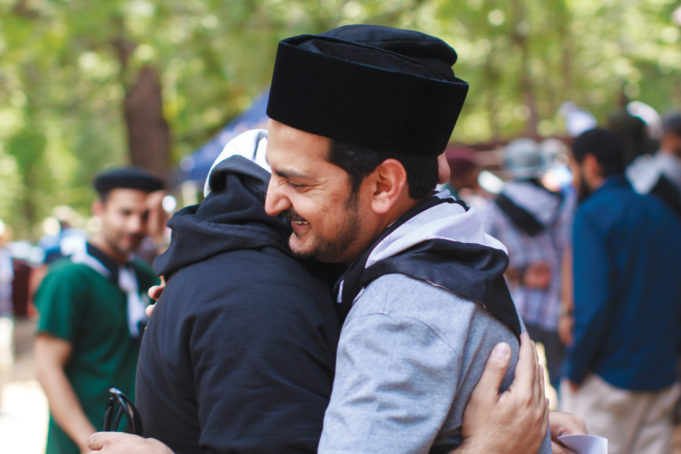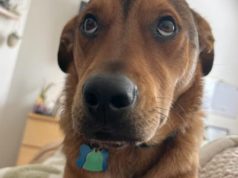Sometimes people tell Najm Saqib to go back home. But the Muslim American is home. Born in Pakistan, the 22-year-old business analyst has been an American citizen since coming to Fort Worth in 2007. At a coffee shop the other day, he quoted the Prophet Muhammad, who praised patriotism toward one’s homeland: “Love of one’s country is a part of faith.”
Saqib leaned over his caramel Frappuccino. “We are part of American society. It is part of our faith to love the country we are living in.”
In late May, Saqib and 574 Muslim men and boys ages 15 to 40 gathered at an annual retreat at Yosemite National Park. Members of the Ahmadiyya Muslim Youth Association met with their brothers from across the country. They hugged. They played sports and trivia games. They prayed on mountaintops.
Their goal: Tell people about Islam and form a Muslim identity that has nothing to do with terror.
Saqib said guest speakers talked to the group about building a stronger relationship with God. They also discussed how to treat and help other people. These thoughts and conversations inspired Saqib to educate people about the “true Islam” by inviting people to his mosque via community service and outreach projects.
When did this fear and hatred of Muslims start? Hint: The phobia has been around since well before the terrorist attacks of 9/11. The pilgrims brought their negative opinions of the Islamic empires home with them to the New World. They put these feelings into action via slavery. Many slaves imported from West Africa were of the Islamic faith and were forced to convert to Christianity.
Even our founding fathers, while crafting the U.S. Constitution, argued over whether to allow Muslims to run for president. But hardcore Christians antagonized Muslims the most in the 19th century. Christ-followers decided that the world needed saving from the non-Christian heathens during the Second Great Awakening. Islam followers hid their faith to avoid religious persecution because of the Protestant revival.
Everything changed during the Great Migration at the beginning of the 20th century. Many mosques were built at this time, when African-Americans moved out of the rural South to urban areas in the North. Mirza Ghulam Ahmad, an Indian religious leader, started the Ahmadiyya movement in 1889. His followers believe that he was the Messiah. They strive to live in his example as “servants of the true Islam,” according to Ahmadiyya.us. The group promotes education, social justice, and community service. The community is alive and well in more than 190 countries with tens of millions of members.
The Ahmadiyya Muslim Community arrived in Philadelphia in 1921, becoming the first organization of its kind here. The youth organization was established in 1939 and is split into groups based on age and gender. Saqib is one of the more than 3,000 male members among the 70 youth chapters nationwide. He was part of the Dallas chapter until the Fort Worth chapter was established in 2012. Many Fort Worth Muslims wanted to benefit from the youth association and couldn’t always make it to Dallas. The Fort Worth group boasts 30 members, four of whom made the recent trip to Yosemite.
Saqib and fellow Fort Worth chapter member Qaisar Butt have been part of the international association since birth, which is not uncommon. The group has converted members of all races and ethnicities as well. Saqib has served as the outreach chairperson ever since the chapter was established. He has made contacts with other local religious organizations in the area and invited them to the association’s events, and he has participated in blood drives and tree plantings.
“Our goal is to get to that level that when you hear about Muslims on TV, you think about us,” Saqib said.
Old habits die hard in America. The police still kill black men under suspicious circumstances with little repercussion. Women still don’t get paid as much as men. It might take the nation a while longer to disassociate terrorism and hate with the Islamic faith.
Butt lamented the sour public opinions expressed about Muslims. Things don’t seem to be getting better, he said.
“I would say it has gotten worse,” he said. “You should look at Donald Trump’s rampages. It depends. It’s a personal perspective, I guess.”
Indeed, it does depend. Saqib said positive viewpoints of Muslims are circulating because social media makes learning about Islam easy. He also pointed out that younger people are more aware and accepting of Muslim issues than older people. As for Trump, Saqib and Butt said he should read the Quran. And that he is welcome to monitor their mosque at any time.
“We are completely open because we have nothing to hide,” Saqib said.
Saqib and Butt plan to continue educating people about Islam and the peace Muslims have to offer. Butt recalled research that showed many Americans do not know a Muslim person. Building connections among the Muslim community and other religious organizations can allow for acceptance of Islamic followers.
“By reaching out, they actually get to know Muslims, what they are, what they stand for,” Butt said. “It can help build harmony sometimes.”
Ahmadiyya Muslim Youth Association of Fort Worth meets at noon on the first Sunday of every month at 1106 W. Pioneer Parkway. Follow them on Twitter @MKA_FortWorth.












